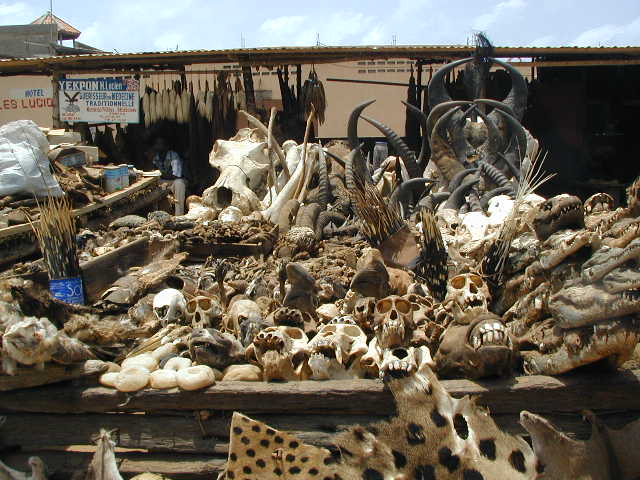
Through Ghana, I'd been traveling with a group of people on a large bus. The rest of my trip was in a Mercedes car, with a driver, guide, and mechanic. The car was comfortable, blissfully air-conditioned, and, surprisingly for the developing world, had seat belts. I noticed that the driver used his, but neither of the other two bothered.
This is as good a time as any to introduce my guide, Georges, a young man (not yet 30) from Lome, Togo. The main thing readers need to know about him is something it took me surprisingly long to realize. Namely, his ability to speak English was limited - and his ability to understand English even more so. Since my French is even more limited (I can read but can't speak or comprehend more than maybe 100 or so words), conversations with Georges tended to be an exercise in non sequiturs. For example:
Georges: This is a Portuguese church.
Me: When was it built?
Georges: The Portuguese built it.
Me: Yes, I understood that. But when? In what year?
Georges: It's a Catholic church.
This probably sounds amusing, but I found myself biting my lip to keep from cussing out of frustration. Actually, I probably should have just gone ahead and said what I was thinking, since the odds were that Georges wouldn't have understood those words either.
Anyway, it took about two hours from Ho to the border at Aflao, even with a couple of stops at customs road blocks (a.k.a. feed the police kitty stops) along the way. The Ghanaian officials give you a disembarkation card, which a clerk painfully hunt and pecks into a computer. While she was searching for keys, I noticed the ledger on the immigration desk. Right below an entry about a Chinese national being denied entry because he didn't have confirmed onward tickets, there was a description of the eclipse.
She finished typing, I got my passport stamped, and we continued on to the Togo side. Or, more precisely, we would have continued on if the driver had actually done the paperwork for the car correctly. Instead, we had to go back for him to get another piece of paper stamped. Then the gate was lifted and we went to Togo immigration, where the formalities were surprisingly quick and pleasant.
After crossing the border, one is more or less immediately in Lome, the capital of Togo. I can't think of any other country which has its capital city so close to a border. Our first stop was at a bank to change money. Both Togo and Benin (and a few other countries) use the West African CFA franc, with the exchange rate being about 530 to the U.S. dollar. It took a while since the one clerk who handled foreign exchange was on a break, but eventually he showed up and we were able to move on.
We drove along the coast (fishing boats and a scenic tropical beach) and through a gritty industrial zone to reach the first sightseeing stop, the festish market. Fortunately, the guide for the market spoke reasonable English. People come to a fetish priest when Western medicine has failed them. The priest diagnoses the problem and comes up with a combination of ingredients, which are burned to a powder. When I asked what the most common problem was, he told me it was "evil spirits." The ingredients include animal heads (even hippos and sea tortoises and chimpanzees, so not just small stuff), hides, feathers, snakes skins, and even entire small animals, as well as herbs. Some have less spiritual medical uses, too. For example, porcupine quills are used to treat asthma. So, in short, the fetish market is where you can meet all your needs for stuff like dried reptiles.

There are also souvenirs (mostly carvings) and the opportunity to buy charms. These wooden charms cover various sorts of good luck - for the household, for travel, for sound sleep, etc.. You put any that you want into a large shell and the priest blesses it with your name. He throws cowrie shells to determine the price and there is some alleged prebargaining built in. That is, I chose the travel charm and he said the price is normally 15000 CFA francs but he threw the cowrie shells again and the spirits were willing to give it to me for 10000. It's odd to bargain with the spirits, but I still gave it a try and offered 5000. After another throw of the cowries, we settled on 8000. By the way, the charm is shaped like a telephone. You tell it where you want to go and hang up the receiver (i.e. put the little peg into the hole) to make it work. I admit to skepticism, but it was still a fun experience.
We drove past a momument to liberty and briefly visited the Transafrica offices. Then we stopped for lunch. Georges seemed pleased that I wanted to try local food and we ordered something called djekoume with chicken. The chicken was ordinary grilled chicken - good, but nothing unusual. Djekoume turned out to be steamed ground maize. It tasted like a sweet corn tamale and was thoroughly delicious. There was also tomato relish and a hot pepper sauce as accompaniments. Combined with Afropop playing in the background, it was an excellent meal.
Then it was time for the Grand Marche (Central Market). This is simply overwhelming, just going on and on. The third (and top) floor features housewares and beads (and a panoramic view of market umbrellas). There were also several people sprawled on benches there, some of them dozing. Apparently, they are traders from various other countries in the region.
The second floor is for textiles. The cloth business is dominated by women, called "Mama Benz" after the expensive cars they can afford from their profits. They import printed fabrics from Europe and work on their accounts in their offices, while their servants sell in the market.
The first (ground) floor of the market is for food - grains, fish, and fruits and vegetables There is quite an abundance, most of it grown within Togo, though apples are imported from South Africa. Eventually we escaped the labyrinthine market stalls and walked back towards the car. On the way, we stopped at a Catholic cathedral, built by the Germans. This is nicely decorated, with lots of murals and stained glass.
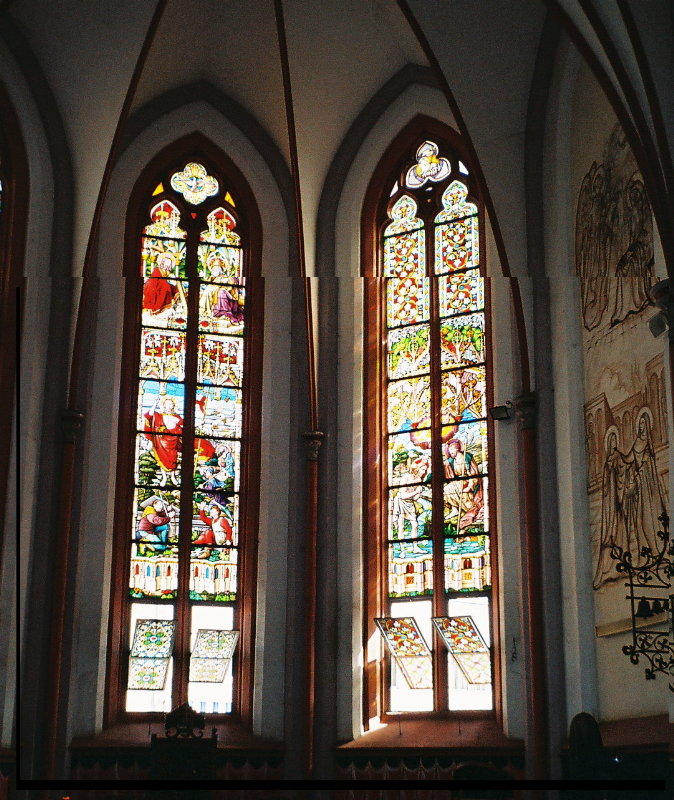
We also stopped at a small street of crafts stalls, where I felt rather hassled - and was, therefore, less inclined to buy anything. I was grateful when we returned to the car, not the least because I really needed the air conditioning at that point. We continued touring Lome by driving around colonial buildings, most of them housing various government ministries, as well as some embassies and consulates. We also drove around the university and Georges said that classes are sometimes so crowded that students have to stand. There are roughly 12,000 students, many of them biding their time in school because of the lack of jobs. Our final stop was to meet with Georges' uncle, who runs a mirror and plate glass factory. Oddly, in French Lessons in Africa, Peter Biddlecombe writes about his meeting with a man who started the first mirror and plate glass company in Togo. I can't help wondering if this was the same person. At any rate, he asked me how the eclipse would inconvenience people. When I asked what he meant, he said that the last eclipse caused a drought. I tried to explain that there was no connection, but I could tell he didn't believe me.
I was grateful to get to the extremely upscale Hotel Mercure Sarakawa and particularly grateful for frostly air conditioning and a very long shower. The opulence even extended to actual brewed coffee, instead of the undrinkable Nescafe that dominates the region. I suspect, though, that I might have been better off at a less ritzy hotel, since the luxury served largely to raise my expectations, which would be shattered fairly quickly over the next few days.
In the morning, we drove a couple of hours to a village for a voodoo ceremony. The trip was largely along narrow dirt roads, that were little more than tracks. We passed several small villages and lots of fields (mostly cassava). I think the name of the village where the ceremony was held was Adventi. At least, thats what was chalked on the wall of a building. The ceremony consisted pretty much of drumming, chanting, and frenzied dancing.
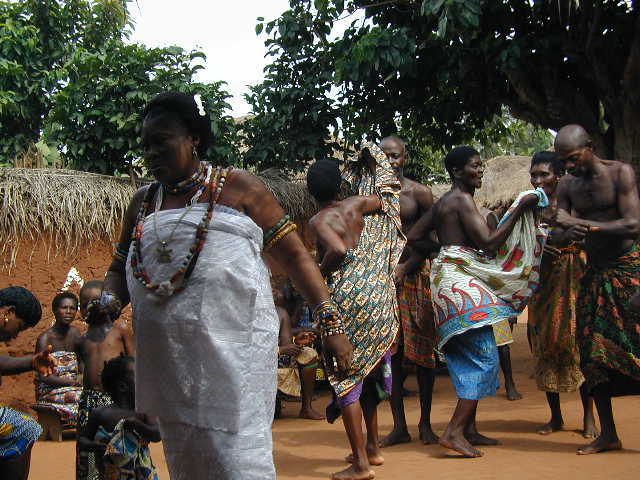
People came in and bowed at the doorway of the building holding the idol, which looked sort of like a haystack. There was also pouring of gin and holy water. The most dramatic event was a woman going into a trance. Other women took her baby from her, helped her as she fell forward, and then sort of wrestled her into one of the buildings. Georges said that celebrations in any given village are once a week, but not always on the same day, since they have their own calendar. He also said the ceremony would continue all day and, in the evening, people who worked in the fields would come from other villages.
We drove on to the border. Formalities on the Togo side were easy and pleasant. On the Benin side, I had to fill out a visa form. The form said it was just for a transit visa for 48 hours and when I pointed that out to Georges, he said it didn't matter. I payed the 10,000 CFA franc fee and they stamped my passport.
Georges claimed that the drive to our next stop, in Abomey, was two hours. After about one hour, we stopped for lunch (fish and potatoes) in Ouidah. It turned out that it was really almost three more hours to Abomey. When we got there, we went to the Palace Museum, which is a UNESCO World Heritage site. Unfortunately, no photographs are permitted there, so you'll have to rely on my powers of description.
The Abomey kingdom lasted from roughly 1600 through 1900, w hen the last king was deported by the French to Gabon. (His predecssor was exiled to Martinique in 1894, by the way.) It was one of the wealthiest African kingdoms, with the source of much of that wealth being the slave trade. In short, the Abomey warriors conquered everyone around them and sold them to the European ship captains. Each of the kings built his own palace in Abomey and two of them are restored. Those are the palaces of Guezo (1818-1858) and Glele (1858-1889). The courtyards of the palaces were cool after an afternoon rain, but the interiors of the buildings - kept locked except when a guide is with you - were stiflingly hot. The exhibits are the usual mix of material on the lives of the royal family and crafts produced for their use. The courage house, where soldiers went to get worked up for war, has both traditional and European weapons, but the real highlight of it is an exhibit on the Amazons, women warriors who were considered fiercer than the men.
The exteriors of several buildings have interesting bas reliefs. Other structures in the complex include temples and burial places of kings. The temples are said to have been constructed of a mixture of clay and human blood. Also, when King Glele died, 41 of his wives were buried alive with him. The claim is that they volunteered, but I'm not convinced they had much choice in the matter.
I'd hoped to find some postcards at the museum shop, but it was closed for the day when we got there. There were several crafts shops open, primarily selling appliques, many of them with the emblems of the various Abomey kings. Not really my sort of thing.
The hotel had been listed on the itinerary as "best in town," a phrase which can strike dread into the heart of the most seasoned traveler. True to my expectations, the Motel d'Abomey was not very good, though tolerable once I got them to actually turn the on water (cold only, of course) in my room. Their restaurant was particularly awful, serving pasty vegetable soup, tough overseasoned meat, and bland rice with peas. Fortunately, the long drive to Abomey had pretty much killed any appetite I might have had. A local artist came by and laid out appliques for sale. There was one I liked, with all of the kings' emblems in a strip. But a German woman from another group told me they were less expensive in Ganvie, which was later on my itinerary, so I passed on it.
The next morning started with a brief stop at a monument to the last Abomey king, who had burned the city to keep the French from getting it. Then we drove to Ketou to visit with a Yoruba King. Georges said the drive would be about a half hour so, of course, it was really about three times that. When we reached Ketou, the driver paid a guy on a motorbike to lead us to the palace. That would set an unfortunate pattern for the day.
We had to take off our shoes to enter the palace, by the way and after squatting for greetings were seated on the porch. I'm never quite sure what to ask in situations like this, so I resorted to a very African question and asked the King how many wives and children he had. He said that he is Catholic, so has only one wife. His people want to give him more wives, but the Church doesn't permit it. He added that having many wives also causes disease. He had seven children, but two are deceased.
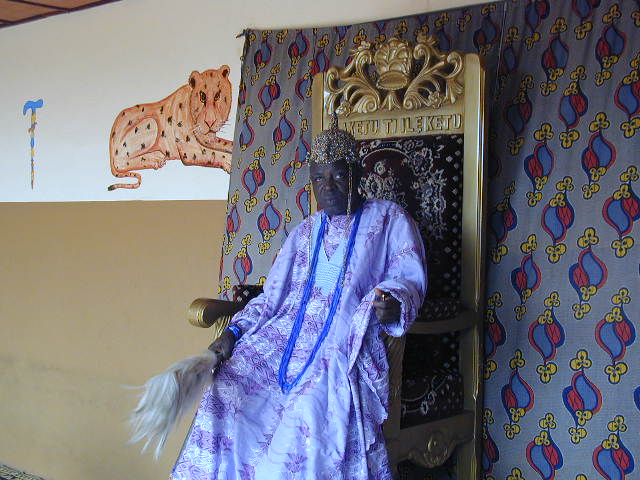
The King was crowned just this past December. His father was the previous king and he was chosen from amongst his brothers. He is over 60 years old, but unsure of his exact age. (By the way, unlike in the U.S., asking somebody's age is a polite question in Africa, as old age is respected.) Before becoming king, he had been a statistician, working as a minister in the Department of Planning. This willingness to abandon the modern and take on a traditional role is common in Africa and is one of the things I find most interesting about the continent. His kingdom has a population of over 100,000, most of whom are farmers
I asked about the relationship of traditional kings and the government. He said that in Nigeria, the government respect tradition and works with the kings, but that things are not as good in Benin. However, he apparently has some influence. For example, before we left, a woman came to ask him to intervene to help a relative who had been arrested for customs violations. By the way, he holds court every day from 10 a.m. to 6 p.m., with Thursdays reserved for the major cases.
We left and had a long drive on a bad road to Porto Novo. This is the official capital of Benin, but Cotonou is the real seat of the government. It took another paid motorbike driver to lead us to the Ethnographic Museum. Georges wanted to go to the museum right away, but it was nearly one in the afternoon, so I said it was better to have lunch first. After eating our couscous at a nearby restaurant, we returned to the museum. Unfortunately, there was a huge school group also at the museum. Between the crowd, the temperature (almost certainly over 100 degrees Fahrenheit), and the lack of air circulation, I was seriously afraid I would faint from heat exhaustion. I managed to escape the attempt at a guided tour and get away from the crowd. I normally find museum tours helpful, but there were good signs (with many of them in English) and it was more important not to sweat to death.
The upper level of the museum is covers the life cycle and is explained via the story of one boy. Before birth, the parents consult a Fa soothsayer. The exhibit includes several examples of what various patterns of cowrie shells mean. For initiation, men dress as women and wear masks - a practice intended to honor mothers. There were also exhibits about friendships and about marriage. Finally, there was a room devoted to funerals. For children and young people, funerals are small and private, but there are elaborate rites for elderly people. The funeral is held about two weeks after death and involves a lot of drums. The key belief is that the souls of the departed return to the family to protect them.
The most interesting part of the museum is the extensive collection of masks, which fill corridors around the rooms of the upper level and an entire gallery on the lower level. Some represent gods, while others represent concepts, e.g. courage, domestic service, unity. All are elaborate and many are huge, with entire scenes on top. There are even modern themes, such as one showing a doctor vaccinating children. I asked Georges if the masks were heavy (a question which required roughly 18 rephrasings to get an answer to) and was told that they're made out of very lightweight wood. Since you're not even allowed to photograph the masks, much less pick them up, I was unable to verify this.
We left the museum and I once again expressed my gratitude for the air conditioning in the car. Our next stop was the Great Mosque, w hich was originally built by the Portuguese as a cathedral and converted into a mosque about a dozen years ago. Getting there was particularly frustrating since Georges had the odd idea that he knew how to get there and could direct the driver. So it took a long time of driving around in circles before he gave up and found a guy on a motorbike to lead the way. Once we got there, I could only see the exterior, since women aren't allowed inside. So it hardly seemed worth the effort.
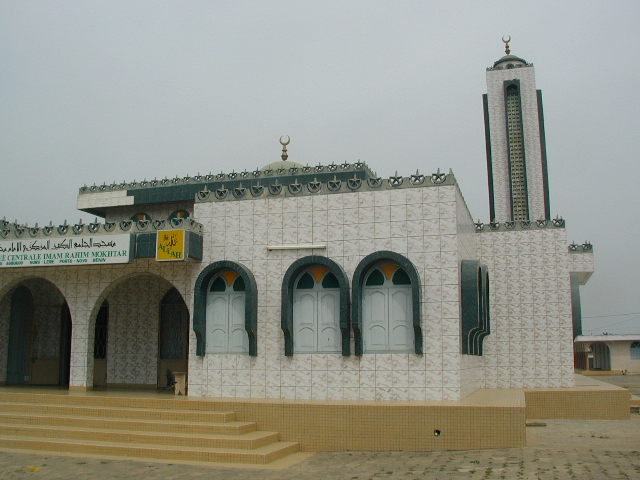
The motorbike guy had waited, fortunately, and led us back towards the center of town and to the drum market. While I liked some of the drums, I didn't like any enough to justify the effort that would be needed to get one home. I also got dragged into a crafts store, where the smell rivaled the stifling heat to make me unwilling to do more than take a quick glance around.
After giving directions to the Grand Marche (the central market), the motorbike guy left us. It took less than five minutes for the driver to get hopelessly lost again. This did have an upside, since we passed a group of people in huge straw masks, sort of like walking brooms. Georges said that they were doing a ceremony for the start of the rainy season. I'd have liked to get a better photo, but there was nowhere for the driver to pull off the road and let me out to do so.
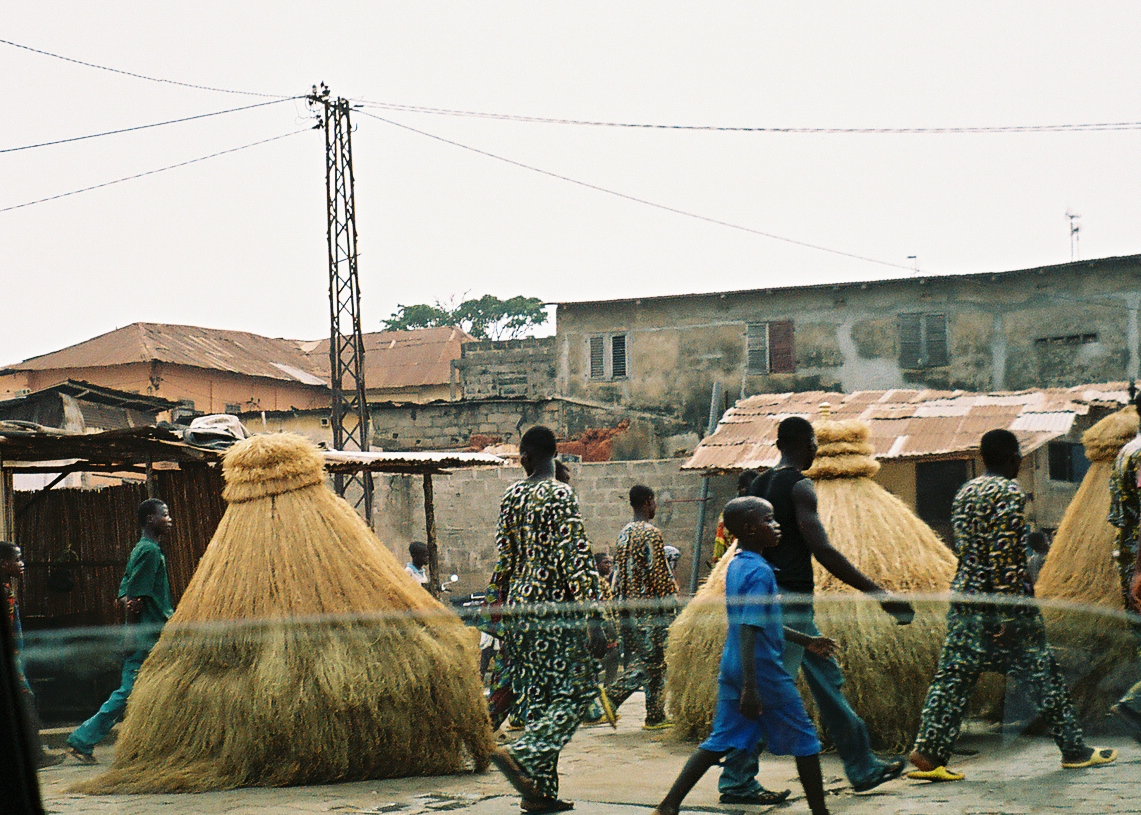
We did, eventually, find the market, after asking directions of 30 some odd people. I was annoyed, but tried to just think of it as being like an Amazing Race challenge. At any rate, the market is pretty much like any other in the region. The most interesting thing I saw was a young albino woman selling herbs.
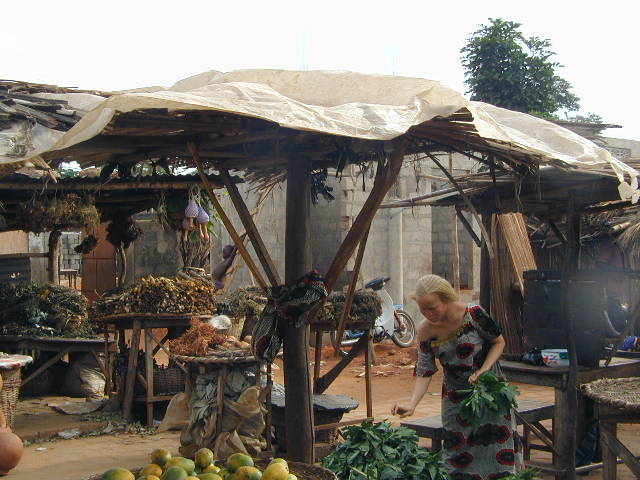
There's a vast assortments of vegetables (okra, eggplant, carrots, greens), grain, and dried fish, as well as textiles and baskets. When we walked past the live poultry section, I asked Georges if people were worried about bird flu. This led to a particularly remarkable series of nonsequitors.
Me: Are they worried about bird flu?
Georges: They sell the birds.
Me: Yes, I see them selling the birds, but I want to know if they are concerned about influenza.
Georges: There are chickens and ducks.
Me: I am asking about the disease that is in birds now.
Georges: They raise the birds in their homes.
I never found out whether the people of Benin are worried about bird flu, but I'm reasonably sure that Georges isn't.
Finally, we continued to the Hotel Bimyns. I have to admit that I was almost astonished when the driver managed to find it on the first try, without assistance. The hotel was adequate. The air conditioning had no temperature control, but I was happy to blast it after the stifling heat of the day. The manager sprinkled some sort of fragrant oil on the floor of the room, for no discernable reason. Dinner consisted of tasty fish and excessively salty potato chips. So there was nothing much I could complain about then. In the morning, however, while breakfast was supposed to be included, all they had was tea. When I asked about food, they offered me fish! Even in France they can usually give you a roll or two, so this made me grumpy.
We drove through Cotonou and on to the landing for boats to Ganvie. Surprisingly, the drive was only an hour, or just about twice what Georges had claimed it would be. Of course, then there was a crisis regarding the boat. First, we waited for the boatman for a long time. When he did show up and we started out, another guy came up and snatched the can of fuel for the engine right out of the boat. Georges claimed that the problem was an argument over whose outboard motor was being used, but I suspect this was wrong since we ended up transferring the motor (and the fuel can) to a different boat. We set out again, but not until the boatman's assistant had a short fist fight with the other guy.
Fortunately, Ganvie was worth the delay. The journey across Lake Nokwe (or, as I nickname all African lakes, Lake Bilharzia) took us past lots of people fishing from pirogues. There are weeds set up to attract the fish, which are caught in nets. Eventually, we arrived at the stilt village.
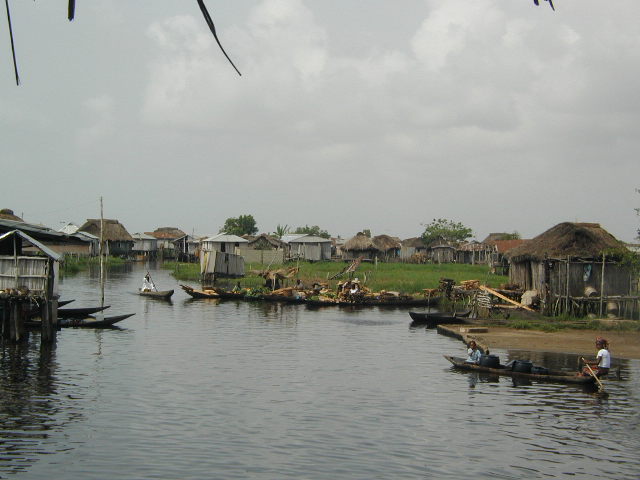
The story is that the Tofinou people built the town in the lake because the Abomey warriors had a taboo against crossing water. So living in a stilt village kept them at peace with their enemies. I asked if the water rises to the top of the stilts during the rainy season. Apparently, though, it isn't the rain that causes the water level in the lake to rise but, rather, water flowing from the Niger River. All in all, it was a pleasant and peaceful place to go, not the least because it was also the only place in Benin that wasn't unbearably hot.
The sightseeing consisted pretty much of boating around the houses, churches, and markets of the village. We also saw lots of people in pirogues, some fishing, some carrying cans of fuel they smuggle from Nigeria. It's all remarkably picturesque.
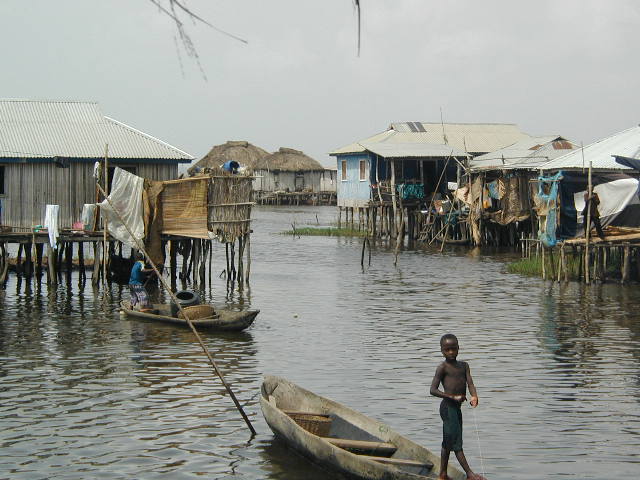
There were also a couple of shopping stops. The appliques were, indeed, cheaper there than in Abomey, but the quality was also inferior. Instead, I bought a few postcards and a t-shirt, with my major justification for the latter being the desire to have something clean to wear home.
We returned to the dock, got back in the car and continued on to Ouidah, where we had lunch at the same restaurant we'd eaten in when we first got to Benin. The first stop there was the Portuguese fort, which hosts a museum of the history of Ouidah. The particular emphasis is on the slave trade. Over 3 million people (about 70% of them Yoruba) were sold as slaves and brought to Brazil, Cuba and Haiti. Many people threw themselves into rivers, preferring to be eaten by crocodiles than to be sold into slavery.
From the museum, we followed the slave route, accompanied by the museum guide, who, fortunately, spoke much better English than Georges did. Right after we set out, we passed another masked procession. This time, the mask was of the god of death, so I thought it might be bad luck to take a photo. The route is marked with symbols of Abomey kings and of Vodun (voodoo) deities. We passed the former locations of other forts (English, French, Dutch, and Danish, if the booklet I bought at the museum is to be believed but German seems far more likely to me than Danish), the site of the slave market, and the place where they were branded. One of the most moving sites is the tree of forgetting, which slaves were made to walk around (7 times for women, 9 for men) so they'd forget their former lives.
When slavery was abolished in Brazil, many descendants of slaves returned to Ouidah. There's a tree of remembrance, which they circled three times to make the spirits of their dead ancestors come home. Finally, we arrived at the beach. The sites there include the door of no return, leading to the sea and slave ships.
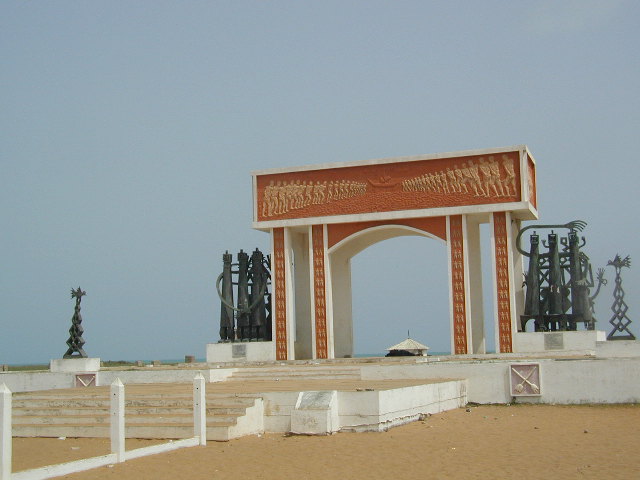
A bit further on, there's the first Catholic mission, built in 1861, after the ending of the slave trade. Finally, there's the door of return, erected to welcome home people returning from the African diaspora.
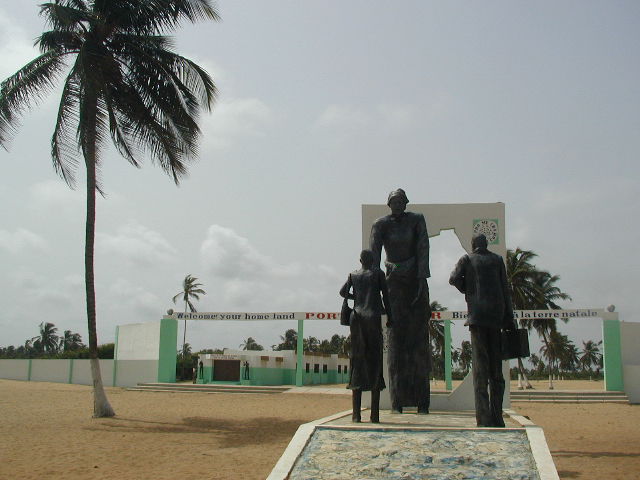
The final sightseeing stop in Ouidah (and, come to think of it, in Benin) was the Python Temple. This is immediately across from the Catholic cathedral, making an interesting contrast.
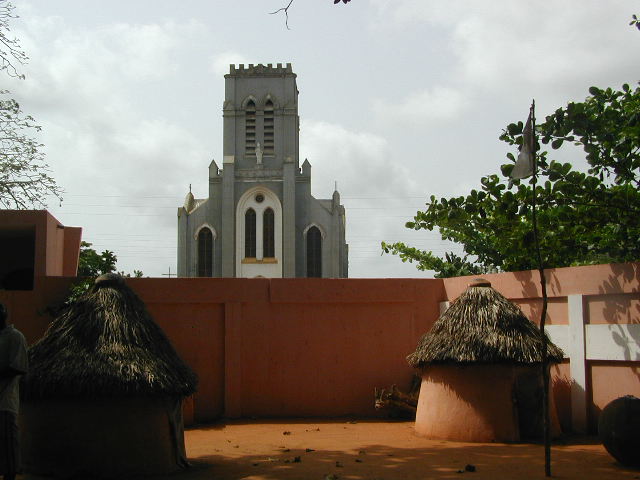
Essentially, it's a voodoo temple wehere pythons are worshipped as gods. There is a ceremony performed every seven years, which starts with 41 virgin girls carrying water from the door of no return to the temple. Georges claimed that if a girl is not a virgin, she will be unable to move with the jug of water. "It's a mystery," he said. "Psychology," I thought.
Adepts of the pythons have their faces scarified in a distinctive pattern. The adept who led us around also said that only good voodoo is practiced at the temple. If somebody tries to use voodoo to do harm to another person, it will backfire on them.
Inevitably, if you're at something called the Python temple, you've got to expect to have a snake slung around your neck. I prefer to think of this photo as one divine creature recognizing another.
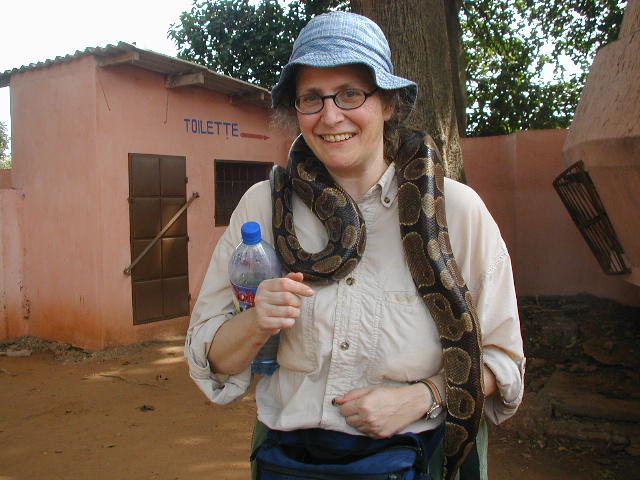
Finally, we went into the chamber where the pythons live during the day. At night, they go out to hunt for rodents. Nobody told me whether they hunt only for voodoo rats, but I suspect they catch Catholic rats, also.
We left the temple and drove to Grand Popo for the night. Georges had told me that the hotel there was very nice, but L'Auberge de Grande Popo has to rank among the 10 worst places I've stayed in my life. While there's a scenic beach, the water is not considered safe for swimming. The room was not particularly clean and had neither air conditioning nor window screens. Under some circumstances, I can find a ceiling fan and mosquito net charming, but it helps when the ceiling fan turns at a reasonable speed and I don't need to use my supply of duct tape to patch holes in the mosquito net. When I got up to use the bathroom in the middle of the night, I saw something move. Instead of putting on my glasses to see what it was, I decided I preferred not to know. Combine that with only a single dim light bulb, an anemic (cold only) water supply, bland and inedible food, and a lot of very noisy French people running back and forth at all hours and I just wanted to get out of there.
I did manage to persuade Georges to leave earlier than he had planned. The drive to the border was reasonably short. Of course, it turned out that the visa they had given me when I entered really was supposed to be just for 48 hours. Surprisingly, they didn't even hit me up for a bribe, but I was nervous until they stamped the exit stamp in my passport. Things were far smoother at the Togo side. In fact, I didn't even need to go into the office there.
We pretty much drove straight across Togo, since I wasn't particularly interested in shopping. Going from east to west, it only take about an hour and a half to cross the country. At the other border, the Togo side was, again, a breeze. At the Ghana side, I had to fill out a form, but there was no hassle. However, there was a long wait to do all the paperwork needed for the car. Georges had said the drive to Accra would be 3 hours, so of course it was about four and a half, not helped by a few police stops along the way. Most of those were customs stops, where they looked at the car paperwork and opened the trunk, but at one I had to show my passport. The police officer commented that the U.S. will play Ghana in the World Cup and I said, "Ghana will probably win." Then he asked why they hadn't stamped my passport at the border in Aflao. When I showed him that they had, he moved on to extracting his bribe from Georges instead, who then grumbled about how corrupt Ghana is for the next hour or so.
When we finally did get to Accra, we had lunch at the restaurant attached to the museum. Then we went to make the one purchase I had said was essential - Ghanaian chocolate for me to bring to my office. A minimarket had a couple of gift boxes of assorted chocolates and I also got a couple of plain milk chocolate bars. For the denouement of that story, you'll have to read the next chapter.
I had a day room at a hotel - not the Novotel, for some mysterious reason, but the considerably less upscale Airside Hotel. At least it had nicely chilly air conditioning and a good hot shower. I put on clean clothes, rearranged my belongings, took a short nap, and watched the local news on television. The major stories included an outbreak of a coconut tree blight and the settlement of a dispute between three tribal chiefs which had apparently delayed a burial for years. Finally, it was time to go to the airport for my flight home.
[ Back to Previous Chapter | Back to Index | On to Next Chapter ]
last updated 20 April 2006